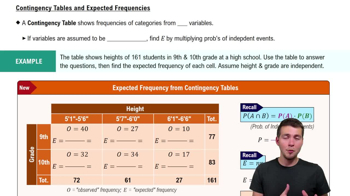A gym owner wants to know if the gym has similar numbers of members across different age groups. The table shows the distribution of ages for members from a random survey. Using x2 = 0.92 & α = 0.05, test the claim that the gym has equal numbers of members of all age ranges.
Table of contents
- 1. Intro to Stats and Collecting Data1h 14m
- 2. Describing Data with Tables and Graphs1h 55m
- 3. Describing Data Numerically2h 5m
- 4. Probability2h 16m
- 5. Binomial Distribution & Discrete Random Variables3h 6m
- 6. Normal Distribution and Continuous Random Variables2h 11m
- 7. Sampling Distributions & Confidence Intervals: Mean3h 23m
- Sampling Distribution of the Sample Mean and Central Limit Theorem19m
- Distribution of Sample Mean - Excel23m
- Introduction to Confidence Intervals15m
- Confidence Intervals for Population Mean1h 18m
- Determining the Minimum Sample Size Required12m
- Finding Probabilities and T Critical Values - Excel28m
- Confidence Intervals for Population Means - Excel25m
- 8. Sampling Distributions & Confidence Intervals: Proportion1h 25m
- 9. Hypothesis Testing for One Sample3h 57m
- 10. Hypothesis Testing for Two Samples4h 50m
- Two Proportions1h 13m
- Two Proportions Hypothesis Test - Excel28m
- Two Means - Unknown, Unequal Variance1h 3m
- Two Means - Unknown Variances Hypothesis Test - Excel12m
- Two Means - Unknown, Equal Variance15m
- Two Means - Unknown, Equal Variances Hypothesis Test - Excel9m
- Two Means - Known Variance12m
- Two Means - Sigma Known Hypothesis Test - Excel21m
- Two Means - Matched Pairs (Dependent Samples)42m
- Matched Pairs Hypothesis Test - Excel12m
- 11. Correlation1h 24m
- 12. Regression1h 50m
- 13. Chi-Square Tests & Goodness of Fit2h 21m
- 14. ANOVA1h 57m
13. Chi-Square Tests & Goodness of Fit
Goodness of Fit Test
Problem 10.1.5
Textbook Question
Finding Expected Frequencies
In Exercises 3–6, find the expected frequency for the values of n and pᵢ.
n=230, pᵢ=0.25
 Verified step by step guidance
Verified step by step guidance1
Step 1: Understand the concept of expected frequency. Expected frequency is calculated using the formula: E = n × pᵢ, where 'n' is the total number of observations and 'pᵢ' is the probability of the specific category or event.
Step 2: Identify the values given in the problem. Here, n = 230 (total number of observations) and pᵢ = 0.25 (probability of the specific category).
Step 3: Substitute the values into the formula for expected frequency. Using MathML, the formula is: . Substituting, it becomes: .
Step 4: Perform the multiplication operation to calculate the expected frequency. Multiply 230 by 0.25 to find the result.
Step 5: Interpret the result. The expected frequency represents the number of occurrences you would expect for the specific category given the total observations and probability.
 Verified video answer for a similar problem:
Verified video answer for a similar problem:This video solution was recommended by our tutors as helpful for the problem above
Video duration:
1mPlay a video:
Was this helpful?
Key Concepts
Here are the essential concepts you must grasp in order to answer the question correctly.
Expected Frequency
Expected frequency refers to the anticipated number of occurrences of a particular outcome in a statistical experiment, calculated by multiplying the total number of trials (n) by the probability of the outcome (pᵢ). In this case, it helps in determining how many times we expect a specific event to happen based on the given probability.
Recommended video:
Guided course

Contingency Tables & Expected Frequencies
Probability
Probability is a measure of the likelihood that a particular event will occur, expressed as a number between 0 and 1. In the context of this question, pᵢ represents the probability of a specific outcome occurring in a sample of size n, which is crucial for calculating expected frequencies.
Recommended video:

Introduction to Probability
Sample Size (n)
Sample size (n) is the total number of observations or trials in a statistical study. It is essential for determining the expected frequency, as a larger sample size can lead to more reliable estimates of probabilities and outcomes, thereby affecting the expected frequency calculation.
Recommended video:

Sampling Distribution of Sample Proportion

 1:17m
1:17mWatch next
Master Goodness of Fit Test with a bite sized video explanation from Patrick
Start learningRelated Videos
Related Practice
Multiple Choice
76
views
